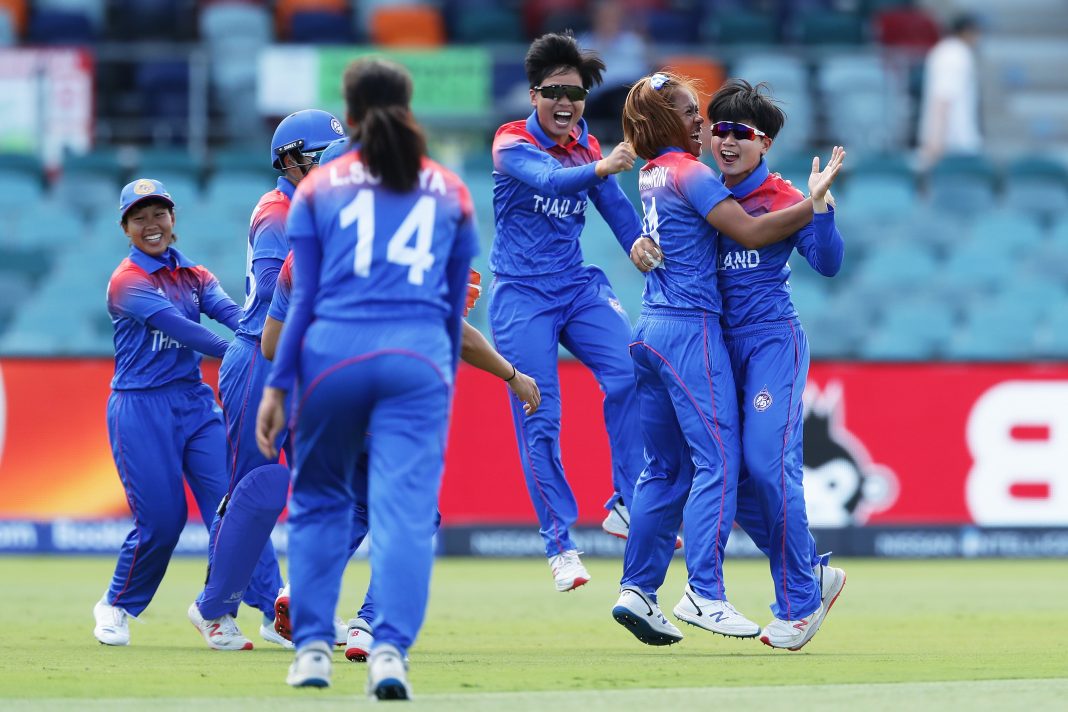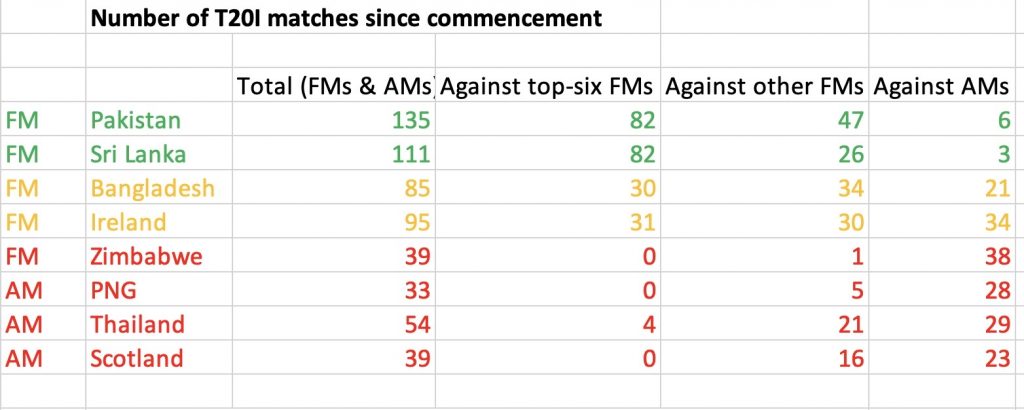
Thailand have made it to the semi-finals of the Asian Cricket Council (ACC) Women’s Asia Cup 2022 in somewhat fortuitous circumstances. Bangladesh’s fixture against the UAE has been washed out, meaning that the reigning champions finish the tournament a point behind Thailand, with two wins (Malaysia and Thailand) and three losses (against India, Pakistan, and Sri Lanka).
It is a searing reminder to the Full Members (FMs) that every match counts.
Thailand’s win against Pakistan last week was another that mattered in this equation. It was characterised as an upset: by ESPN Cricinfo in their match report, by Pakistani opener, Sidra Ameen in the post-match press conference, and perhaps even implicitly by Thailand’s captain, Naruemol Chaiwai, who was “happy with the win…against a top-class team.”
Pakistan are ranked 6th in the ICC Women’s T20I rankings, Thailand 12th. Viewed on the basis of this metric, it was an unexpected victory. But Thailand and Pakistan have only faced off two other times in T20Is. In 2018, the Pakistanis crushed their South East Asian counterparts by eight wickets in the Women’s Asia Cup. Then came Thailand’s splendid batting effort at the T20 World Cup 2020, a probably victory spoiled by the rain in Sydney.
It is a head-to-head record that momentarily raises the question of whether these two teams are more evenly matched than is suggested. Three games is too small a sample size to make any enduring comparison between the two teams, and therein lies a key problem. Thailand – like other Associate Members (AMs) – just have not had enough opportunities to play their FM counterparts.
Last week’s win against Pakistan did not garner the kind of attention that Thailand’s performance at the Sydney Showground did. In part, this is because Thailand are now – almost universally – expected to compete with the lower-ranked FMs. In the last five years, they have beaten Sri Lanka, Bangladesh, and Pakistan, and have trumped Ireland and Zimbabwe on multiple occasions.
Thailand are not the only Associate team on this trajectory. Scotland beat Ireland by five wickets in the ICC Women’s T20 World Cup Europe Region Qualifier 2021. UAE beat Zimbabwe by four wickets in the ICC Women’s T20 World Cup Global Qualifier 2022. And for all the big victories that the FMs claim against the AMs, there are an increasing number of tight finishes.
There has been much written about the “gordian knot of power politics at the heart of the global governance of cricket.” It became visible in the way in which participation for the ICC Women’s World Cup (ODI) and the next cycle of ICC Women’s Championship was decided last year. An abandoned tournament saw the ICC grant the West Indies, Pakistan, and Bangladesh spots in the World Cup, and Sri Lanka and Ireland places in the Championship on the basis of a ranking system which excluded the AMs altogether. Status intersected with the facade of meritocracy to ensure the draw bridge was pulled up before any AMs – Thailand in that instance – could cross it.
The T20I format is slightly different in that all international T20I fixtures, including those between Associates, are accorded the same status, and count towards ranking points in a more inclusive table. But the gordian knot still rears its head in A.) the number of matches that FMs are guaranteed, and B.) in the fact the majority of FMs are never required to qualify for World Cups, regardless of their records.
This article sheds light on the discrepancies between match played against different levels of opposition regardless of results, over many years. It does so by comparing the T20I records of the five lowest ranked FMs (based on average time spent outside the top six rather than current rankings), and the three highest ranked AMs. These countries are Pakistan, Sri Lanka, Bangladesh, Ireland, Zimbabwe, PNG, Thailand, and Scotland.
Table one compares the number of T20I matches these eight countries have played since commencement of their T20I journeys. A caveat of this data is that the year of commencement varies, with the FM vs FM matches awarded T20I status, long before the ICC standardised the status of all international T20 matches in 2018. The article sticks with the varying commencement years, in part to denote that AM matches that did not have T20I status prior to 2018 (almost always against other AMs) did not count towards ranking points. Colour codes delineate between FMs that have never been required to participate in T20 World Cup qualifying tournaments (green), the teams that have qualified for the next T20 World Cup (amber), and the teams that have not qualified for the next T20 World Cup (red).

First, Pakistan and Sri Lanka have played a significantly higher number of T20Is than Bangladesh and Ireland and up to 3.5 times the number of T20Is of the lowest-ranked FM, Zimbabwe. Pakistan and Sri Lanka have also played anywhere from 2.5 to 4 times more T20Is than the AMs on this list. In turn, Bangladesh and Ireland have played between 2 and 3 times the number of T20Is than Zimbabwe, and the AMs.
Second, Pakistan and Sri Lanka have also each played a whopping 82 T20Is against the top-six FMs, namely Australia, England, India, New Zealand, South Africa, and the West Indies. Bangladesh and Ireland have played just under third of this number. From among the AMs, only Thailand has played any matches against the top-six FMs, courtesy of their appearance at the last T20 World Cup.
These numbers show the extent to which the FMs, barring Zimbabwe, are guaranteed a much higher number of T20Is against higher quality opposition over time. Within this FM grouping, Pakistan and Sri Lanka have been able to negotiate a higher number of matches than Bangladesh and Ireland. This access to consistent fixtures has not only helped players gain exposure and experience required to take their games to the next level, whilst making a crucial difference in high stakes matches at World Cup qualifiers, often against AMs.
Third, Thailand has played 21 matches against the other FMs outside the top-six, namely the five on this list. This number is only so high because of Thailand’s consistent participation in the Asia Cup – one of the few tournaments which guarantees AMs fixtures against FMs – and self-organised series against Zimbabwe and Ireland. Scotland too has benefited from regular competition with Ireland and from participation in the Commonwealth Games. The point here is that AMs have to rely on competitive fixtures outside of the ICC’s ambit, in order to secure matches against the FMs.
Fourth, without being compelled to do so, Pakistan and Sri Lanka have played a negligible number of T20Is against AMs, as compared to the other six countries who have played an average of 29 matches against AM opposition. There is, of course, little incentive for these two teams to play lower ranked, and AM sides.

Table 2 compares the track records of these eight teams in T20Is. First, despite being guaranteed a significant number of games against the top six FMs, Pakistan and Sri Lanka have low win percentages of 17% and 13% respectively against these sides. Extraordinarily, in 24 T20Is against Australia, England, and New Zealand, Sri Lanka has never beaten any of those teams. Sri Lanka’s record against India (22 matches, 4 wins), the West Indies (23 matches, 4 wins), and South Africa (13 matches, 3 wins) is only marginally better.
Similarly, Pakistan has never beaten Australia or England, has beaten England just once in 14 matches. Pakistan has only beaten India three times in 13 games (Friday’s win at the Women’s Asia Cup was the first since 2016). A record of seven wins in 18 matches against South Africa lends an air of respectability to Pakistan’s record against the top six teams. The records of Bangladesh (3 wins out of 30) and Ireland (2 wins out of 31) against the top six are even more dismal.
Despite being unable to win consistently against the top FMs over many years, Pakistan, Sri Lanka, and to a lesser extent Bangladesh and Ireland, are continuously given opportunities to play against these sides. Moreover, there are no consequences for such poor records. The ICC competition structure has no clear and consistent promotion and relegation system, and the ranking system, on which participation decisions are made, has problems with ‘decay rate’ (the value of older games in attributing points), complicated further by the sheer inconsistency of fixtures.
By contrast, the AMs simply cannot get any fixtures against the top six teams. There are no substantive win-loss records to substantiate this reality. Why do teams like India, England, Australia, and New Zealand choose to play so many more matches against Pakistan and Sri Lanka, than against the lower ranked FMs and the AMs?

Second, both Scotland and Thailand have comparable win percentages to Ireland in matches against the five FMs on this list. Even so, Ireland has played 14 and 9 more T20Is against FMs than Scotland and Thailand. This is a trajectory that is likely to continue with Ireland’s inclusion in the ICC Women’s Championship, bringing regular opportunities to add T20I fixtures to planned ODI series over three years.
Third, Zimbabwe and the three AMs on this list average a win percentage of 84% against other AMs. Some of these games are against lower-ranked AMs in regional tournaments, but they are the only readily available fixtures for these teams. Just as Pakistan and Sri Lanka have competed regularly and failed miserably against the top six, Zimbabwe and the AMs have competed regularly and succeeded against their AM compatriots. Yet the status quo of fixture classes remains. What more can Zimbabwe, Thailand, Scotland, and PNG do to prove their credentials as worthy, regular opponents for the FMs?
These numbers demonstrate the lower ranked FMs have benefited from the power to negotiate guaranteed fixtures and ensure World Cup participation despite exceedingly poor on-field records. In the same breath, it is clear that the game’s top ranked AMs have done everything they possibly can with limited resources to deserve regularised, meaningful fixtures against the top teams in the world.
Until the ICC Women’s Championship expands significantly, and the ICC mandates regular fixtures for top AMs against FM sides, teams such as Thailand, Scotland, PNG, the UAE, and USA will have to be content with a smattering of fixtures in qualifying tournaments or in non-ICC events. The onus will once again be on them to cause that next ‘upset’ and reprove their credentials. Or to rely on the rain for good fortune.
You’re reading Emerging Cricket — brought to you by a passionate group of volunteers with a vision for cricket to be a truly global sport, and a mission to inspire passion to grow the game.
Be sure to check out our homepage for all the latest news, please subscribe for regular updates, and follow EC on Twitter, Facebook, LinkedIn and YouTube.
Don’t know where to start? Check out our features list, country profiles, and subscribe to our podcast.
Support us from US$2 a month — and get exclusive benefits, by becoming an EC Patron.






